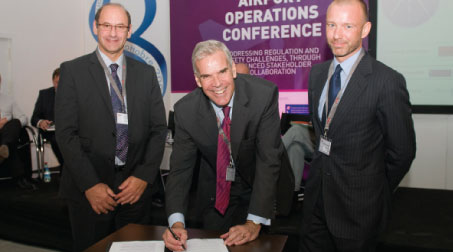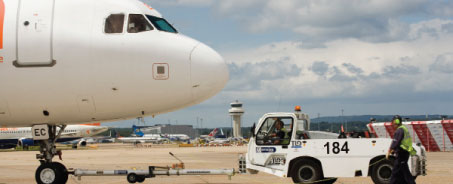
CANSO officially joined the A-CDM Action Plan in October at ACI EUROPE’s Airport Exchange event in Istanbul. “The implementation of A-CDM has the potential to be a key contributor to the continued growth of European aviation,” Lake said.
A-CDM is integral to the successful implementation of the SESAR (Single European Sky ATM Research) operational concept and the idea behind it is to improve the operational efficiency of all airport partners by reducing delays, streamlining the predictability of events during the progress of a flight and optimising the utilisation of resources.

Adamson: “One of our big objectives is to reduce the environmental impact of aviation by 10% per flight and airports have a very important role to play.”
While more than 30 airports are so far engaged in implementing the programme, the latest ACI EUROPE & EUROCONTROL target outlines an ambition to have A-CDM fully implemented at 10 of these airports by the end of 2011. As it stands, two airports – Munich and Brussels – have already fully implemented A-CDM.
“The result is a win-win situation for all partners involved: airports, airlines, air navigation service providers and ground handlers,” said Olivier Jankovec, Director General, ACI EUROPE. “Ultimately, this timely optimisation of resources helps to make the journey smoother for the passenger and reduces environmental impact.”
At the heart of the successful implementation of A-CDM is information sharing and, allied with the implementation of the Target Off-Block Time (TOBT), Variable Taxi Time and the calculation of the Target Start-Up Approval Time (TSAT), this creates an all-encompassing sequence designed to improve overall operational efficiency.
Jacques Dopagne, director network management, EUROCONTROL, explained “A-CDM is a vital component for efficient operations in the future and for the performance of the European network and is a cornerstone of the SESAR concept. Apart from providing an immediate increase in airport efficiency, it is also the link to collaborative environmental management, which is intended to address environmental issues which may limit the future growth of European aviation.”
Growing partnership
Having officially joined the Action Plan in October at the 5th annual Airport Exchange in Istanbul, CANSO is further pushing this message and according to Graham Lake, CANSO’s director general: “A-CDM is an important tool for transforming global ATM performance, and all industry stakeholders must collaborate to ensure its timely and successful implementation.”
He continued “The implementation of A-CDM has the potential to be a key contributor to the continued growth of European aviation. This was identified in 2008 when it was included as a key component of the European Flight Efficiency Plan developed by CANSO, EUROCONTROL and IATA.”
In terms of its importance concerning the overall SESAR programme, A-CDM has been identified as the key to integrating airports into the Air Traffic Management (ATM) network. While airports have not in the past played an active role in the ATM process, Collaborative Decision Making provides a perfect platform to bridge this gap and further establish airports as “ground coordinators” within the overall Single European Sky project.
“Airports can be seen as black holes,” explained Paul Adamson, SJU (SESAR Joint Undertaking) Programme Manager at SESAR JU. “Currently, you can predict what’s going to happen between the airports, but not actually when the aircraft are at the airports themselves. CDM is the main way of integrating all of the players within the airport environment.”
While the optimisation of operational efficiency is a central element, the environmental and financial benefits of the programme are not to be overlooked. For instance, Heathrow Airport – which is among the airports currently engaged in implementing A-CDM – has reported that taxi times have been reduced by approximately two minutes for each departure and that every £1 invested in implementing the programme results in a long-term return of nine-times this amount. Munich Airport, meanwhile, has reported that waiting times spent on the ground with engines running have been reduced by one-third as a direct result of A-CDM implementation.
Adamson added “One of our big objectives is to reduce the environmental impact of aviation by 10% per flight and airports have a very important role to play. Planning the traffic and having the aircraft arrive on time, ensuring that engines are turned off on the stand, and planning the departure sequence correctly are all essential parts of reducing the environmental footprint of an aircraft movement. Also, for aviation as a whole, if aircraft are arriving and departing on time, this creates a good perception of the industry for the passenger.”

More than 30 airports are currently engaged in implementing A-CDM and the latest target outlines an ambition to have the programme fully implemented at 10 of these airports by the end of 2011.
Future strategy
In order to achieve the ambitious targets for 2011, the ACI EUROPE, EUROCONTROL and CANSO partnership has developed a clear strategy and a vital part of this is to continue to promote the importance of the initiative and the benefits that it can bring.
“A clearer message will be delivered to the airport community that A-CDM will bring benefits to their operation, and to drive this message home, these benefits will be quantified from some of the airports who are now considered A-CDM compliant,” Dopagne explained. “It is evident that as traffic continues to grow, airports will demand greater flexibility in their operations and A-CDM will deliver this.”
Acknowledging the progress that has already been made, Lake echoed this commitment to delivering a clear message, outlining that greater participation should not be limited by airport size or traffic volume.
He added “In an increasingly data-centric environment, A-CDM requires a step-by-step approach and it’s a way of working that becomes part of operational procedures and subject to ongoing review and development in consultation with industry partners.
“The operational and capacity gains that have been realised so far provide a benchmark for airports across Europe, and as the number of airports to achieve full implementation increases, we will have more data to demonstrate these benefits in real terms to A-CDM stakeholders.”
Targets for full A-CDM implementation
By the end of 2011, the target is for A-CDM to be fully implemented at 10 airports:
- Amsterdam Schiphol
- Brussels
- Frankfurt
- Helsinki
- London Gatwick
- London Heathrow
- Munich
- Paris CDG
- Prague
- Zurich








